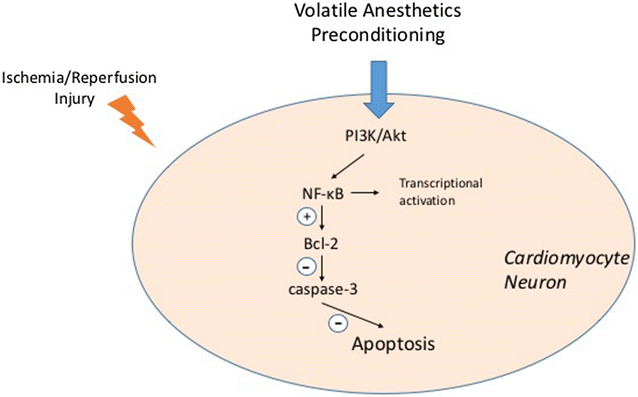Comparison of volatile anesthetic-induced preconditioning in cardiac and cerebral system: molecular mechanisms and clinical aspects
- PMID: 29458412
- PMCID: PMC5819224
- DOI: 10.1186/s40001-018-0308-y
Comparison of volatile anesthetic-induced preconditioning in cardiac and cerebral system: molecular mechanisms and clinical aspects
Abstract
Volatile anesthetic-induced preconditioning (APC) has shown to have cardiac and cerebral protective properties in both pre-clinical models and clinical trials. Interestingly, accumulating evidences demonstrate that, except from some specific characters, the underlying molecular mechanisms of APC-induced protective effects in myocytes and neurons are very similar; they share several major intracellular signaling pathways, including mediating mitochondrial function, release of inflammatory cytokines and cell apoptosis. Among all the experimental results, cortical spreading depolarization is a relative newly discovered cellular mechanism of APC, which, however, just exists in central nervous system. Applying volatile anesthetic preconditioning to clinical practice seems to be a promising cardio-and neuroprotective strategy. In this review, we also summarized and discussed the results of recent clinical research of APC. Despite all the positive experimental evidences, large-scale, long-term, more precisely controlled clinical trials focusing on the perioperative use of volatile anesthetics for organ protection are still needed.
Keywords: APC; Apoptosis; Ischemia–reperfusion injury; Mitochondria.
Figures
References
-
- Werner C, Möllenberg O, Kochs E. Schulte J am Esch. Sevoflurane improves neurological outcome after incomplete cerebral ischaemia in rats. Br J Anaesth. 1995;75:756–760. - PubMed
-
- Engelhard K, Werner C, Reeker W, Lu H, Möllenberg O, Mielke L, Kochs E. Desflurane and isoflurane improve neurological outcome after incomplete cerebral ischaemia in rats. Br J Anaesth. 1999;83:415–421. - PubMed
-
- Lutz M, Liu H. Inhaled sevoflurane produces better delayed myocardial protection at 48 versus 24 hours after exposure. Anesth Analg. 2006;102:984–990. - PubMed
-
- Chiari PC, Pagel PS, Tanaka K, Krolikowski JG, Ludwig LM, Trillo RA, Jr, Puri N, Kersten JR, Warltier DC. Intravenous emulsified halogenated anesthetics produce acute and delayed preconditioning against myocardial infarction in rabbits. Anesthesiology. 2004;101:1160–1166. - PubMed
-
- Deng J, Lei C, Chen Y, Fang Z, Yang Q, Zhang H, Cai M, Shi L, Dong H, Xiong L. Neuroprotective gases–fantasy or reality for clinical use? Prog Neurobiol. 2014;115:210–245. - PubMed
Publication types
MeSH terms
Substances
LinkOut - more resources
Full Text Sources
Other Literature Sources


